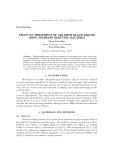
Paper industry effluents
-
Alkaline pulping liquors are the problematic for environment due to their toxicity and poor biodegradability. During last decade, anaerobic treatment technology has been successfully applied to various types of pulp and paper industry effluents. In the present study, the treatment of highly toxic pulping liquors in lab-scale has been done using sulfate reducing bacteria (SRB) isolated from sediment samples of pulp and paper mills in Vietnam. This treatment could reduce 70 - 75% of COD after three weeks. The COD removal could achieve 82 - 88% by subsequent aerobic treatment in 48 hours.
 7p
7p  12120609
12120609
 01-06-2020
01-06-2020
 9
9
 1
1
 Download
Download
CHỦ ĐỀ BẠN MUỐN TÌM













